REVIEW: Schofield No.3 Air Pistol
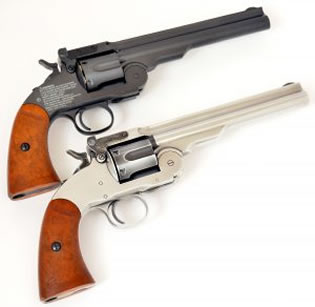
Enjoy a beautiful piece of history with the replica Schofield No.3 Revolver from Bear River. An authentic BB version of the classic Smith & Wesson No.3 Schofield revolver from 1875, the first thing you'll notice is the precision craftsmanship and attention to detail. Each revolver feels heavy and balanced in your hand, available in an authentic gunmetal finish with an included 1 year warranty.
It's indiscernible from the real thing with the exception of the discreet safety switch located just behind the hammer. It loads, cocks and fires as does the original. The barrel is heavy but so was the case with the original given the length.
Shooting the replica Schofield No.3 Revolver is a joy with a smooth single action, CO2 power, and authentic 6 shot cylinder. Load BBs into the included metal cartridges, and reloading is easy with the top break design. Perfect on the range, for firearm proficiency and training, or backyard plinking, the Schofield No.3 Vintage Revolver from Bear River is the right pistol at the right price.
|
Airgun Specifications:
|
Airgun Features:
|
More information about this product.
Additional Schofield No.3 Air Pistol Photos
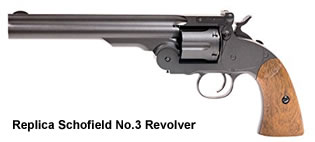

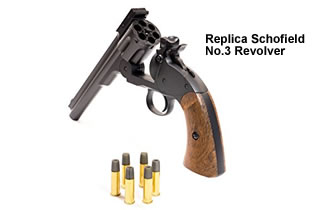
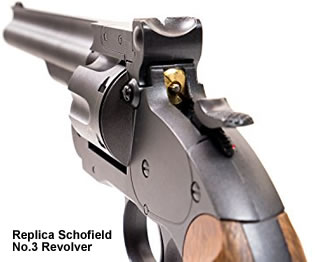
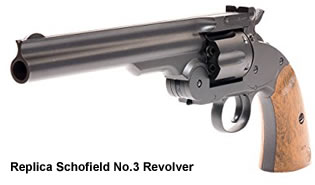
Amazon.com Product and Customer Reviews
Most helpful customer reviews
10 of 11 people found the following review helpful.
![]() Overall very impressive!
Overall very impressive!
By Jaxter
It's indiscernible from the real thing with the exception of the discreet safety switch located just behind the hammer. It loads, cocks and fires as does the original. The barrel is heavy but so was the case with the original given the length.
The pistol comes in a blister pack which makes it appear cheap and doesn't provide for storage as would a box. I suggest you order a pistol case with it. My only gripe about this revolver is the white safety information on the right side of the frame. It reminds me of the small print at the bottom of the screen from a TV ad and takes away from an otherwise very realistic looking pistol. Unless the manufacturer's attorneys or some federal mandate requires this paragraph I hope they delete this very long and distracting safety warning.
If you're looking for a realistic appearing western plinker this and the Umerex Colt Peacemaker (I have both) are it.
4 of 5 people found the following review helpful.
![]() Collectible disappointment!
Collectible disappointment!
By Amazon Customer
Consider the Colt SAA 7.5" "Peacemaker" as a benchmark for collectible BB or Pellet CO2 revolvers concerning realism, quality and performance, the Bear River Schofield is just another CO2 pistol. While it has the shape of the venerable Schofield it does not have the "Class Act" engineering that went into the Colt. The finish on the pistol bears no resemblance to that of the 1870's piece. The finish appears to be no more than the standard type used on most pieces in the "air pistol" genre. The "half cock" position on the hammer which released the break lever for opening to reload has been removed entirely, which leaves a potential on this "replica" for breaking open if a "fast draw" is practiced or, perhaps, just being bumped. These things and perhaps a certain level of engineering (Colts Level) would place this piece in the same category that the Colt replica enjoys. But, except for the shape, nothing else moves this piece out of the "just another CO2 pistol" category. I would not even think about buying the 500 + dollar engraved edition of this "replica", much less the current asking price. I'm sorry I did. I expected more! I'll not address the poor positioning of the warning label.
0 of 0 people found the following review helpful.
![]() Five Stars
Five Stars
By Ted Jarsen
good quality. Haven't fired it yet, but am sure it will be a great addition to my collection
History behind the firearm that inspired the Schofield No.3 Air Pistol
The Smith & Wesson Model 3 was a single-action, cartridge-firing, top-break revolver produced by Smith & Wesson from circa 1870 to 1915.
It was produced in several variations and sub-variations, including both the "Russian Model", so named because it was supplied to the military of the Russian Empire (41,000 No. 3's were ordered in .44 caliber by the Imperial Russian Army in 1871), and the "Schofield" model, named after Major George W. Schofield, who made his own modifications to the Model 3 to meet his perceptions of the Cavalry's needs. Smith & Wesson incorporated these modifications into an 1875 design they named after the Major, planning to obtain significant military contracts for the new revolver.
The S&W Model 3 was originally chambered for the .44 S&W American and .44 Russian cartridges, and typically did not have the cartridge information stamped on the gun (as is standard practice for most commercial firearms). Model 3 revolvers were later produced in an assortment of calibers, including .44 Henry Rimfire, .44-40, .32-44, .38-44, and .45 Schofield. The design would influence the smaller S&W .38 Single Action that is retroactively referred to as the Model 2.
U.S. Army Schofield Revolver
The U.S. Army adopted the .44 S&W American caliber Smith & Wesson Model 3 revolver in 1870, making the Model 3 revolver the first standard-issue cartridge-firing revolver in US service. Most military pistols until that point were black powder cap and ball revolvers, which were (by comparison) slow, complicated, and susceptible to the effects of wet weather.
In 1875 the US Ordnance Board granted Smith & Wesson a contract to outfit the military with Model 3 revolvers incorporating the design improvements of Major George W. Schofield (known as the "Schofield revolver"), providing that they could make the revolvers fire the .45 Colt (AKA ".45 Long Colt") ammunition already in use by the US military. Smith & Wesson instead developed their own, slightly shorter .45 caliber round, the .45 Schofield, otherwise known as the .45 S&W.
When it became obvious in the field that the two cartridges would not work interchangeably in the Schofield (although they both worked in the Colt), the U.S. Government adopted the shorter .45 Schofield cartridge as the standard cartridge. Despite the change, old stocks of the longer .45 Colt rounds in the supply line caused the Army to drop most of the Schofields and continue with the Colt. Major Schofield had patented his locking system and earned a payment on each gun that Smith & Wesson sold, and at the time his older brother, John M. Schofield, was the head of the Army Ordnance Board and the political situation may have been the main issue for the early end of army sales.
Many of the S&W Model 3 Schofield revolvers saw service in the Indian Wars, and there are reports of them in use as late as the Spanish-American War and Philippine-American War. Like the other Smith & Wesson Model 3s, they were also reportedly popular with lawmen and outlaws in the American West, and were reportedly used by Jesse James, Bob Ford (who used one to kill James), John Wesley Hardin, Pat Garrett, Theodore Roosevelt, Virgil Earp, Billy the Kid, and many others. The Smith & Wesson No. 3 revolver was famously used by Wyatt Earp during the OK Corral Gunfight with the Clanton Gang.
While the standard barrel length was 7", many Schofields were purchased as surplus by distributors, and had the barrels shortened to 5", and were refinished in nickel. After the Spanish American War of 1898, the US Army sold off all their surplus Schofield revolvers. The surplus Schofield revolvers were reconditioned by wholesalers and gunsmiths (at professional factory-quality level) with a considerable number offered for sale on the commercial market with a 5-inch barrel as well as the standard size barrel of 7 inches.
Of the most notable purchasers of these reconditioned model 3 Schofield revolvers was Wells Fargo and Company, who purchased the revolvers for use by Wells Fargo Road Agents and had the barrels shortened to a more concealable 5 inches length. These revolvers were then inspected by the Wells Fargo armorer and uniquely stamped "W.F. & Co" or "Wells Fargo & Co", along with the original Smith & Wesson serial number re-stamped alongside the Wells Fargo stamping on the flat part of the barrel just forward of the barrel pivot as well as re-stamping any part of each revolver which had not originally been stamped or stamped in a location that would be difficult to view the serial number, when needed.
The Wells Fargo Schofield revolvers became so popular with collectors from the 1970s onwards that the unique Wells Fargo markings were being "counterfeited" or "faked" by unscrupulous sellers to enhance the value of other similar versions that had not been genuinely owned by Wells Fargo & Co. There are more "fake" Wells Fargo marked Schofield revolvers than genuine ones in existence and, accordingly, a collector interested in purchasing a "Wells Fargo" Schofield revolver would be well advised to have a pre-purchase inspection and verification performed by an expert who specializes in this model.
